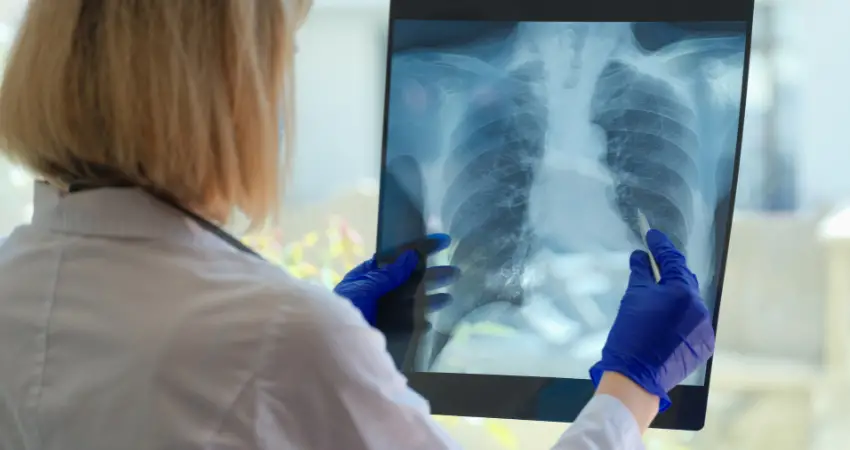What is COPD? Understanding Chronic Obstructive Pulmonary Disease
Chronic Obstructive Pulmonary Disease (COPD) continues to be a critical healthcare challenge in Oxford and across the UK.
Traditional methods of diagnosis, like spirometry, are plagued with shortages and delays. In this context, the introduction of AI-driven technology to identify COPD patients comes as a groundbreaking innovation.
Chronic Obstructive Pulmonary Disease, or COPD, is a common medical condition affecting the lungs. It’s a term used to describe several lung diseases that block airflow as you exhale, making it difficult to breathe.
What Causes COPD?
COPD is most commonly caused by smoking, though exposure to certain gases or fumes, and genetic factors can also play a role.
Types of COPD
There are two main types of COPD:
- Chronic Bronchitis: This involves long-term coughing with mucus production.
- Emphysema: This damages the air sacs in the lungs, making it harder to breathe.
Symptoms of COPD
People with COPD might experience:
- Difficulty breathing
- Coughing with mucus
- Wheezing
- Tiredness
These symptoms can get worse over time, making daily activities more challenging.
Diagnosis of COPD
Doctors usually diagnose COPD based on symptoms, medical history, and a lung function test called spirometry. This test measures how much air you can breathe in and out, and how quickly you can do it.
Treatment for COPD
While there is no cure for COPD, the following treatments can help manage the symptoms:
- Medication: Inhalers and pills can help open the airways.
- Lifestyle Changes: Quitting smoking, eating well, and exercising can make a big difference.
- Oxygen Therapy: Some people may need extra oxygen.
- Surgery: In severe cases, surgery might be an option.
Managing COPD requires a combination of medical treatment and lifestyle changes. With the right care, many people with COPD live full lives.

AI-Driven Technology for COPD Assessment in Oxford
Oxford’s GPs, practice nurses, and pharmacists are the first in the UK to pilot this advanced AI technology. The system has the potential to revolutionize COPD diagnosis by drastically reducing waiting lists and enhancing the efficiency of testing.
The Shortcomings of Traditional COPD Testing and the Innovation of TidalSense
The traditional test used to detect COPD is spirometry, a method dating back to the 1800s. With this test in short supply across the UK, healthcare company TidalSense has introduced state-of-the-art AI technology for assessing COPD, paving the way for faster and more accurate diagnoses.
Details of the N-Tidal Device: A Game-Changer in COPD Diagnosis
The newly launched N-Tidal device features a high-resolution carbon dioxide sensor, coupled with an AI platform. This innovative technology can measure subtle changes in lung function that may indicate COPD. It’s a quick process – from breath to result takes less than five minutes.
The Oxford Trial: Real-World Testing of the N-Tidal Device
In Oxford, healthcare professionals will conduct a comprehensive trial on up to 600 patients with suspected or confirmed COPD over a 12-week period. By comparing the N-Tidal device’s results with traditional spirometry tests, the trial aims to validate the device’s effectiveness and efficiency.
Potential Impact on COPD Diagnosis and Care
The implications of this technology are vast. Dr. Helen Ashdown, a respected clinical lecturer at the University of Oxford, believes the N-Tidal device has the potential to transform COPD diagnosis and management. Improved patient outcomes and better overall care could be the new norm.
Collaboration with Healthier Oxford City Network: A Joint Effort
The trial marks a significant collaboration with Healthier Oxford City Network, a network comprising four primary care practices. It shows a strong commitment to innovation and patient care within the Oxford community.
Clinical Studies and Future Implications
Clinical studies have already demonstrated over 91% accuracy in diagnosing severe COPD from a single breath recording. This technology is set to replace spirometry in some NHS diagnostic clinical pathways, moving toward a more automated diagnostic test.
TidalSense CEO’s Vision: A New Era in COPD Diagnosis and Primary Care
Dr. Ameera Patel, CEO of TidalSense, emphasizes the need to modernize primary care with precise, easy-to-perform tests. By enabling early and accurate diagnosis, the AI technology can reduce healthcare inefficiencies, delays, hospitalization costs, and, most importantly, enhance patients’ quality of life.
Conclusion: Artificial Intelligence in Nursing
The introduction of AI-driven technology for COPD assessment in Oxford could signal the beginning of a new era in healthcare.
This revolutionary approach promises faster diagnosis, improved patient care, and an overall more efficient healthcare system.
The successful trial and implementation of the N-Tidal device have the potential to redefine standards in COPD care and treatment, not just in Oxford but across the entire UK.
It’s a step that symbolizes the synergy of medical expertise and technological advancement, working together for the greater good of patients and the healthcare system.

